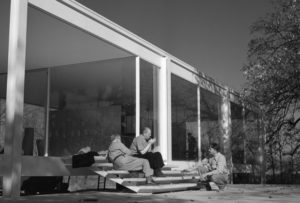Witold Rybczynski's Blog, page 16
June 13, 2020
ANYTHING GOES
 It was the great Cole Porter’s birthday on June 9. In 1934 he wrote the musical Anything Goes.
It was the great Cole Porter’s birthday on June 9. In 1934 he wrote the musical Anything Goes.
The world has gone mad today
And good’s bad today
And black’s white today
And day’s night today . . .
And though I’m not a great romancer
I know that you’re bound to answer
When I propose
Anything goes
Seems about right.
June 8, 2020
AT THE PEARLY GATES
 I note that Christo Javacheff passed away recently. I was not a fan of his work, nor of his considered self-promotion. On the occasion of his and Jeanne-Claude’s Gates project in Central Park I wrote in Slate: “Jeanne-Claude has been quoted as saying that she thinks that Olmsted would be “very happy” with the installation. My guess is that he would have hated it.”
I note that Christo Javacheff passed away recently. I was not a fan of his work, nor of his considered self-promotion. On the occasion of his and Jeanne-Claude’s Gates project in Central Park I wrote in Slate: “Jeanne-Claude has been quoted as saying that she thinks that Olmsted would be “very happy” with the installation. My guess is that he would have hated it.”
June 3, 2020
THE THIN VENEER

The veneer of civilization is perilously thin. I was living in Montreal during the 1969 policemen and firemen’s strike. It lasted only sixteen hours but that was long enough for things to unravel. For the first half day, drivers observed traffic light signals, then they started to go through orange lights, and pretty soon they were disregarding red lights altogether. That was only the beginning. According to the CBC, which called it a night of terror: “At first, the strike’s impact was limited to more bank robberies than normal. But as night fell, a taxi drivers’ union seized upon the police absence to violently protest a competitor’s exclusive right to airport . . . Shattered shop windows and a trail of broken glass are evidence of looting that erupted in the downtown core. With no one to stop them, students and separatists joined the rampage.” Looting was widespread; a provincial policeman was shot and killed. The New York City 1977 blackout started in the evening and lasted all night and most of the following day. Riot, looting, arson. Thirty five blocks of Broadway were destroyed. More than five hundred police officers were injured and almost four thousand looters were arrested. The cost of damages was estimated to be more than a billion dollars in present-day dollars.
May 21, 2020
MOVING THE BOX
 Blair Kamin, the architecture critic of the Chicago Tribune, recently tweeted a May 19 photograph of Mies van der Rohe’s famous Farnsworth House almost inundated by the rising waters of the nearby Fox River. Kamin writes that the water level appears to be receding, so it seems likely that the house may be spared, at least this year. Although its floor is raised five feet in the air, because Mies sited the house on low ground only 75 feet from a river that regularly overflows its banks in the spring, the house has been flooded several times, the first as early as 1954, only three years after it was built. A 1996 flood brought several feet of water into the house and blew out a window. One solution, because the house is basically a (glass) box on stilts, would be to move the whole thing to higher ground on the property. Instead, the National Trust for Historic Preservation, the current owner, is considering installing hydraulic jacks that will raise the house whenever the river floods. The rationale for this contraption, is that changing the location of the house would compromise the architect’s vision. The truth is that Mies designed the same steel and glass boxes irrespective of their setting and location—urban or rural, Montreal or Mexico City. “It’s ridiculous to claim that the house’s siting is essential to its authenticity, especially given Mies’s basic approach to universality,” says my Penn colleague David De Long, an architect and experienced preservationist who has consulted on the conservation of several Frank Lloyd Wright houses, including Auldbrass in South Carolina. “Wright’s houses, which were more specifically designed for a specific site, have been successfully moved without major compromise,” he points out.
Blair Kamin, the architecture critic of the Chicago Tribune, recently tweeted a May 19 photograph of Mies van der Rohe’s famous Farnsworth House almost inundated by the rising waters of the nearby Fox River. Kamin writes that the water level appears to be receding, so it seems likely that the house may be spared, at least this year. Although its floor is raised five feet in the air, because Mies sited the house on low ground only 75 feet from a river that regularly overflows its banks in the spring, the house has been flooded several times, the first as early as 1954, only three years after it was built. A 1996 flood brought several feet of water into the house and blew out a window. One solution, because the house is basically a (glass) box on stilts, would be to move the whole thing to higher ground on the property. Instead, the National Trust for Historic Preservation, the current owner, is considering installing hydraulic jacks that will raise the house whenever the river floods. The rationale for this contraption, is that changing the location of the house would compromise the architect’s vision. The truth is that Mies designed the same steel and glass boxes irrespective of their setting and location—urban or rural, Montreal or Mexico City. “It’s ridiculous to claim that the house’s siting is essential to its authenticity, especially given Mies’s basic approach to universality,” says my Penn colleague David De Long, an architect and experienced preservationist who has consulted on the conservation of several Frank Lloyd Wright houses, including Auldbrass in South Carolina. “Wright’s houses, which were more specifically designed for a specific site, have been successfully moved without major compromise,” he points out.
April 19, 2020
A PRIVATE FUTURE
 In 1973, my friend Martin Pawley published The Private Future: Causes and Consequences of Community Collapse in the West. According to his Guardian obituary (he died in 2008) the book “foresaw a society with ever greater technical means of communication becoming paradoxically more insular and dysfunctional.” Here is an extract (which appeared in full on the jacket of the original hardcover): “Alone in a centrally heated, air-conditioned capsule, drugged, fed with music and erotic imagery, the parts of his consciousness separated into components that reach everywhere and nowhere, the private citizen of the future will become one with the end of effort and the triumph of sensation divorced from action. When the barbarians arrive they will find him like some ancient Greek sage, lost in contemplation, terrified and yet fearless, listening to himself.” The Private Future was written before the internet, iPods, and smart phones. Martin expected a publishing success but the message was too farfetched—and too bleakly dystopian—for the reading public. In our time of social distancing and self-quarantining the book seems more apposite than ever.
In 1973, my friend Martin Pawley published The Private Future: Causes and Consequences of Community Collapse in the West. According to his Guardian obituary (he died in 2008) the book “foresaw a society with ever greater technical means of communication becoming paradoxically more insular and dysfunctional.” Here is an extract (which appeared in full on the jacket of the original hardcover): “Alone in a centrally heated, air-conditioned capsule, drugged, fed with music and erotic imagery, the parts of his consciousness separated into components that reach everywhere and nowhere, the private citizen of the future will become one with the end of effort and the triumph of sensation divorced from action. When the barbarians arrive they will find him like some ancient Greek sage, lost in contemplation, terrified and yet fearless, listening to himself.” The Private Future was written before the internet, iPods, and smart phones. Martin expected a publishing success but the message was too farfetched—and too bleakly dystopian—for the reading public. In our time of social distancing and self-quarantining the book seems more apposite than ever.
April 9, 2020
i-BAUHAUS

Western Electric Model 302, c. 1930s
Nicholas Fox Webber, the author of a biography of Le Corbusier, has recently published iBauhaus. I have not read the book yet, but the subtitle, “The iPhone as the Embodiment of Bauhaus Ideals and Design,” says it all. There is no doubt that the iPhone is a minimalist, no frills machine and proud of it. It is also a quintessentially Bauhaus example of form follows predetermined aesthetics rather than form follows function. The iPhone doesn’t fit the human hand particularly well, certainly not as well as the classic Western Telephone Model 500 handset designed by Henry Dreyfuss in the 1940s. The predecessor of the Model 500 was the Western Electric Model 300 designed by Bell Labs engineer George Lum in the early 1930s, about the same time that the Bauhaus school moved to Berlin. I have an iPhone, and I’ve had a Wassily Chair and I formed no attachment to either.
I-BAUHAUS

Western Electric Model 302, c. 1930s
Nicholas Fox Webber, the author of a biography of Le Corbusier, has recently published iBauhaus. I have not read the book yet, but the subtitle, “The iPhone as the Embodiment of Bauhaus Ideals and Design,” says it all. There is no doubt that the iPhone is a minimalist, no frills machine and proud of it. It is also a quintessentially Bauhaus example of form follows predetermined aesthetics rather than form follows function. The iPhone doesn’t fit the human hand particularly well, certainly not as well as the classic Western Telephone Model 500 handset designed by Henry Dreyfuss in the 1940s. The actor of the Model 500 was the Western Electric Model 300 designed by Bell Labs engineer George Lum in the early 1930s, about the same time that the Bauhaus school moved to Berlin. I have an iPhone, and I’ve had a Wassily Chair and I formed no attachment to either.
April 3, 2020
POST-PANDEMIC
 According to the United Nations Secretary-General, the coronavirus pandemic is the “greatest test” the world has faced since the United Nations was formed in the wake of the Second World War. One of the results of that global war was the ascendancy of modernist architecture, which until then had been a distinctly Bohemian side show of little import. It was not until the postwar 1950s that steel and glass office towers and precast concrete housing blocks appeared—and came to dominate the built environment. One wonders if a post-pandemic world will see a comparable phenomenon. Of course, a plague does not materially lay waste cities, but its debilitating social, economic, and human effects could be as drastic.
According to the United Nations Secretary-General, the coronavirus pandemic is the “greatest test” the world has faced since the United Nations was formed in the wake of the Second World War. One of the results of that global war was the ascendancy of modernist architecture, which until then had been a distinctly Bohemian side show of little import. It was not until the postwar 1950s that steel and glass office towers and precast concrete housing blocks appeared—and came to dominate the built environment. One wonders if a post-pandemic world will see a comparable phenomenon. Of course, a plague does not materially lay waste cities, but its debilitating social, economic, and human effects could be as drastic.
April 2, 2020
RULES

El Greco, Portrait of a Man, 1575 (thought to be Palladio)
A friend of mine recently emailed me a telling criticism of New Urbanism. “I’ve noticed a strange need to quantify everything from these guys. It’s almost like they are trying to deduce a pattern . . . and even worse . . many would lean toward legislating the pattern.” There it is in a nutshell. Of course, ever since Palladio wrote Quattro Libri, architects have been fascinated by the dimensions of things—of rooms, ceiling heightss, doors, windows, and so on. Palladio had rules about all of them. But he was always careful to allow for exceptions. Writing about the height of ceiling vaults, for example, he observed, “There are other heights for vaults which do not come under any rule, and the architect will make use of these according to his judgement and practical circumstances.” Judgement, not legislated patterns.
March 23, 2020
GLASS FOLLY

Mies (center) during the construction of the Farnsworth House
Alex Beam’s interesting new book on the saga of the Farnsworth House, which I reviewed in the Wall Street Journal recently, raises an interesting question. How can a house that has so many functional drawbacks, that is basically dysfunctional, be considered a modernist masterpiece? The answer reveals more about modernism than it does about masterpieces. Modernist buildings are often described as clean and functional. Beam’s book makes clear that the glass house in Plano was neither. The glazed wall got sooty from the heating system, and was covered with condensation during cold weather. Dr. Farnsworth spent the first part of her summer weekends hosing down the exterior. A glass box gets unbearably hot in the summer, a porch without netting is unusable in a mosquito infested riverbank, and a kitchen organized in a straight line is not really convenient. The list goes on and on. Beam’s account makes clear that these shortcomings were not really accidents—Mies was simply willing to ignore practicalities. He used fragile travertine as an exterior paving, ignored issues like ventilation, and built perilously close to the Fox River, which regularly flooded. Nor, despite the bare-bones appearance of his buildings, was he really a skilled builder. The eaves were so poorly detailed they leaked almost immediately. He was an aesthete—appearance was all. Like the builder of a Victorian folly, Mies took an architectural conceit to its ultimate and illogical end.
Witold Rybczynski's Blog
- Witold Rybczynski's profile
- 178 followers



